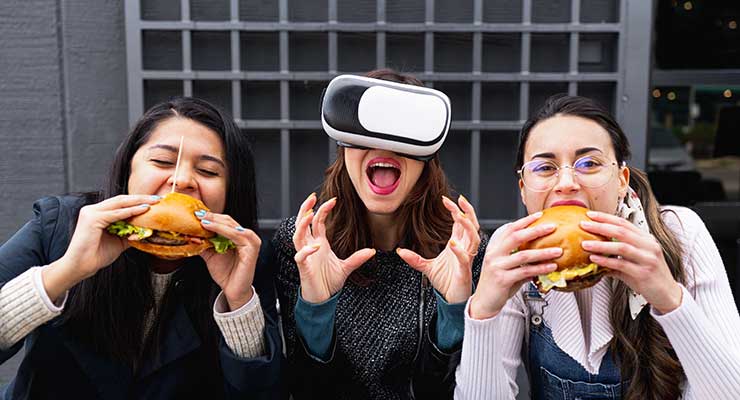
The metaverse megatrend:
The virtual universe is tipped to become the new hub of life.
Seriously?
The metaverse is a topic on everyone's lips – especially now that Mark Zuckerberg has renamed his Facebook empire Meta. However, most of us are still scratching our heads in confusion, unsure of what to think or where to start with it. Meanwhile, many big corporate players like McDonald's have already set about discovering and conquering this new virtual sphere of life.
This article will explain more about the why and how of the metaverse and clarify a couple of key terms. We take a trip over the pond to take a look at two examples of how famous food chains in the USA are taking their first steps in the metaverse – and what future opportunities the realm might offer for the retail and food service industries.
What does the term "metaverse" mean?
The term was coined in a science fiction novel from 1992 (Snow Crash by Neal Stephenson). In it, the metaverse is a virtual world in which the characters take refuge from their chaotic real-life environment.
Meta is a Greek prefix that roughly translates as "behind", "above" or "after". Blended with "universe", the portmanteau "metaverse" is formed to describe a second, virtual world that exists above or alongside the real one.
What does the metaverse consist of?
The metaverse is a digitally created world – it is made up of bits and bytes, of ones and zeros. Everything that exists there is the result of programming, of hardware and software. It is often described as the 3D version of the Internet, expanded through the possibilities of virtual reality (VR) and augmented reality (AR).
What is the difference between virtual reality (VR) and augmented reality (AR)?
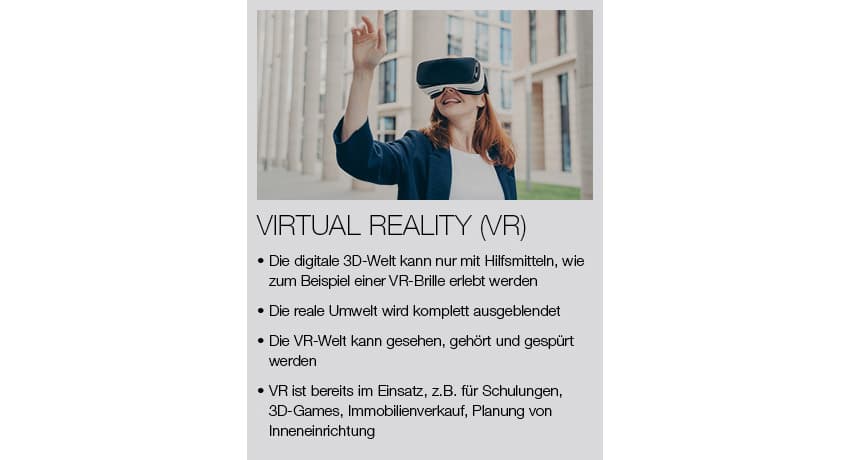
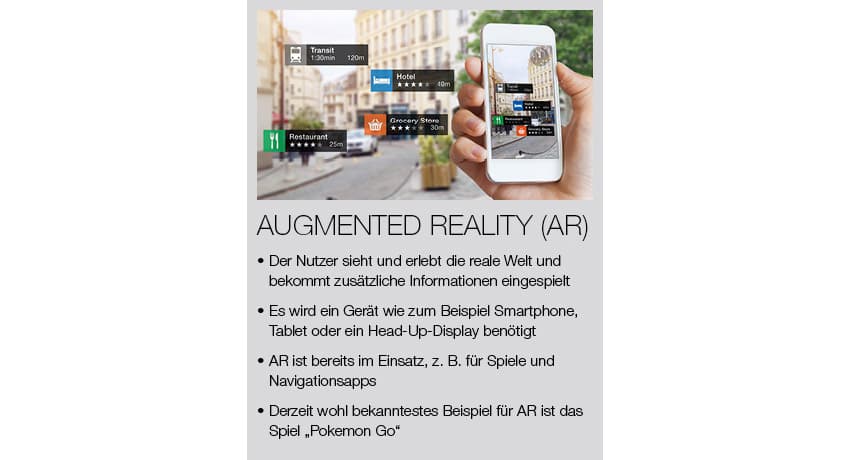
How does the metaverse work?
Generally speaking, just like the Internet, although the metaverse needs significantly higher computing capacities. In technical terms, it is based on an interconnection of data centres all over the world. It is likely that there will be several metaverses from different operators, who will probably build their own data centres for their metaverse.
One metaverse or several?
It is likely that numerous different metaverses will be created. Even if the development of a complete metaverse is still largely in its infancy, tech giants like Meta, Apple, Google and Microsoft are all hard at work on their versions of the metaverse. Everyone wants to have the best metaverse and thus bag the leading market position. The first public presentations are planned for 2024.
What is inside the metaverse?
The metaverse can have everything that exists in the real world – and then some. To move around the metaverse, each user creates their own avatar, a virtual version of themselves. The metaverse will contain cities and parks, restaurants and shops, meeting points and relaxation areas. Your avatar can interact with others and even conduct business. In the metaverse, users will be able to buy and manage digital property. Cryptocurrencies and NFTs will primarily be used as currency and valuables (see below for more info).
What can you do in the metaverse?
Through your avatar, you can do whatever you like in the metaverse. You can go shopping, go to a concert, take a stroll through the park, dine at a restaurant, meet friends, collect artwork – only that it's all digital. The possibilities really are endless.
Founded in 2003, the relatively well-known online community Second Life, in which users can meet, chat, shop and even marry as their avatars, is generally considered to be a simple precursor of the metaverses to come.

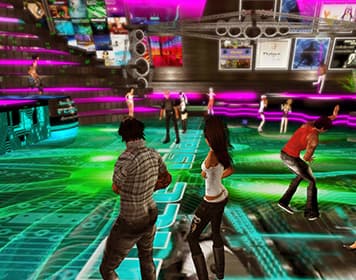
Like we have already seen with the Internet, the metaverse (or metaverses) will continuously develop based on the needs and wishes of users. Cities will certainly offer everything we see in real-world metropolises – including shopping centres, restaurants and advertising space.
The great thing about the metaverse is that people can go there simply to relax and play games or experience a fantasy life. In the metaverse, the virtual 3D technology will also make shopping a whole new experience. The metaverse can also be used to experience something that exists in the real world but is not easily accessible.
What opportunities does the metaverse offer to companies?
The metaverse will present exciting new possibilities, especially in terms of marketing, customer loyalty and new customer acquisition. But how will this work in the food service industry? After all, avatars won't really be able to eat and drink in the metaverse.
But there are many ways in which the food service industry can offer unique gourmet and culinary experiences in the metaverse.
On the one hand, a new generation of consumers is growing up, who are practically impossible to reach via traditional advertising channels. At the same time, these young consumers are very familiar with the Internet, Instagram and TikTok and are extremely receptive to communication via digital channels.
On the other hand, consumers in the metaverse can take part in virtual experiences that might not otherwise be possible without having to travel there specifically, such as eating at a far-off restaurant, a winery or a cheese dairy.
Through their avatars, consumers can take part in guided tours, get to know the products, see the menu, take a look round the kitchen and experience entire menus as virtual 3D versions. This creates customer loyalty, awakens desire and ultimately triggers intent to buy in the real world.
Using the example of a restaurant, a visit in the metaverse could translate into a reservation being made in the real world. Or the restaurant might offer complete menu packages or individual dishes which are then delivered directly to the user at home. Of course, the metaverse can also be used to make online orders and reservations.
Other possibilities are loyalty discounts or special offers that can only be claimed via the metaverse. Similar to Facebook, Instagram and TikTok today, the aim will be to gain fans and remain attractive and relevant to the target group through suitable promotions.
What will happen with money in the metaverse?
New technologies are not created for their own sake, but rather with the aim of generating new markets and earning money. The simplest approach might see consumers being directed via the metaverse back to existing channels like the Internet or stores in order to make purchases there. In this case, everything would remain as it is.
However, the metaverse follows a different form of thinking. It is not only about the purchase of goods or pleasures in the real world. In the metaverse, users' avatars can also do business, acquire property or even plots of land or unique collector's items.
The basis for these transactions will be cryptocurrencies, such as bitcoin (probably the best-known cryptocurrency, although there are many others).

Cryptocurrencies, NFTs and blockchain – how are we supposed to keep up with all of this?
Let's take it one step at a time. Generally speaking, a cryptocurrency works just like normal money. You pay a specific price for a specific item. The only difference is that in this case, you don't actually hand over notes and coins, but rather a new record is added to a blockchain.
What is a blockchain?
The blockchain is a large, decentralised database. A blockchain system starts with an initial block, and all further information is added to the chain sequentially. You could say the blockchain is like a large Excel file, but with the difference that only new entries are added and no old ones are deleted. All transactions are recorded in chronological order and cannot be changed, meaning that they remain traceable forever.
What is a cryptocurrency?
Bitcoin is the first and best-known cryptocurrency in the world. The name is a combination of "bit", which is a digital storage unit (usually a 0 or 1) and "coin", to signify money. In other words, bitcoin is a digital coin. It is an entirely virtual currency which has no real notes or coins. The main different between standard and digital money is that cryptocurrencies function independently of states or banks. A cryptocurrency has no real value, but is rather determined only by demand. All transactions are logged and recorded in the blockchain. The blockchain serves as the "digital accounting book" of the cryptocurrency.
What is a non-fungible token (NFT)?
An NFT is a digital asset. Like cryptocurrencies, NFTs are based on a blockchain, in other words, a decentralised database. Each NFT describes a unique, virtual asset that can only be assigned to one owner. NFTs are often compared to artworks or collector's items.
NFTs are therefore unique, virtual objects of value in the form of a data set that can be uniquely assigned to an owner. Normally, data can be copied and passed on. However, NFTs are difference. Here, every transfer is tracked in order to identify the rightful owner.
This might be a plot of land or a work of art in the metaverse. The value of these NFTs is not fixed, but is rather based on supply and demand – just like real estate, collector's items and artwork in the real world.
An NFT for 69 million dollars
NFTs were first surrounded by hype in the spring of 2021, when the auction house Christie's sold its first purely digital artwork for the record price of 69 million dollars (!) – the highest price that had ever been paid for an NFT.
McDonald's first NFT and other plans in the virtual world
To mark the seasonal relaunch of the McRib in the USA in 2021, McDonald's gave away ten McRib NFTs among app users – meaning that each winner won a uniquely assignable digital image of the real burger. Alongside the advertising and PR effect, the aim was to achieve a rapid increase in value of these NFTs and therefore attract more attention. However, the McRib NFT is currently bobbing along at around 20 dollars.

Even if the McRib NFTs are not yet being traded for millions, the campaign certainly earned the company a lot of attention on US soil. Upon closer inspection, it quickly becomes clear that McDonald's sees ample opportunities in future digital developments like the metaverse.
The chain has filed patent applications that prove it is in the process of developing "virtual restaurants". As we spend ever-increasing amounts of time online, McDonald's predicts that teenagers who meet and hang out in burger restaurants today will soon opt to log on to VR equivalents where they can chat with friends in fun surroundings and order food and drink to be delivered to their real-life homes.
The company is also thought to be planning to sell virtual goods in the metaverse – for example, in the form of branded clothing and merchandise for avatars or customers' virtual homes in the metaverse.
The company's patent applications suggest that it is also interested in the further development of NFTs. This is a sign that McDonald's will continue to work on the creation of collector's items or personalised promotional items in the future.
Chipotle Mexican Grill gets burritos rolling in the metaverse
In April 2022, Chipotle launched its Burrito Builder on the online gaming platform Roblox. In a virtual Chipotle restaurant, gamers' avatars have a limited time to roll a burrito. If they succeed, they win Burrito Bucks.
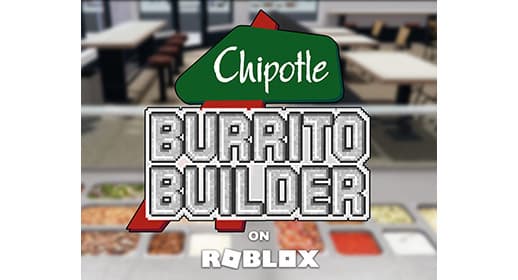
The first 100,000 Roblox players to successfully roll a burrito receive enough Burrito Bucks to exchange for a code that can be used to order food via the Chipotle app or website. The digital currency can also be used to buy food in a Chipotle restaurant in real life. This is an example of how the metaverse can be used to acquire new customers and retain existing ones, and as a loyalty campaign.

This shows how the metaverse can be used, for example, to acquire new customers, retain customers and as a loyalty campaign.
Will the metaverse really become our new way of life?
It is still impossible to provide a definitive answer to this question today. Despite all the hype, the development of a complete metaverse is still in its infancy. However, since many large corporations and innovative start-ups are investing so much effort in it, it is safe to say that relatively well-developed metaverses will emerge in the foreseeable future. The market research institute Grand View Research estimates that in the year 2030, the metaverse market will be worth some 680 billion dollars.
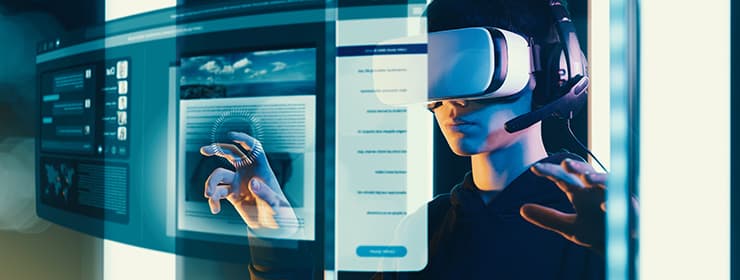
The metaverse will allow people to be reached in new and surprising ways. Companies will be given previously unimaginable opportunities to present themselves to consumers in original and entertaining ways. People will be able to earn money with the metaverse and for this reason alone, it will become part of our lives – just as the Internet has forged its place as an indispensable component of our everyday existence since the mid-1990s.
Like with TV and the Internet, there will be people who will spend a lot of time with these new technologies. And there will be those who decide to steer well clear. One thing is certain: younger target groups will use the new medium more than their elders from the outset. For a new generation of consumers, the metaverse will be as matter-of-course as the Internet is for us today.
As far as companies are concerned, although there is no immediate need to rush in and jump on every bandwagon, they should certainly keep an eye on developments. Just as practically every food service company now has its own website and offers diners online booking and ordering options, having a presence in the metaverse will probably be commonplace in the not-too-distant future.
 Eye-catcher with added value
Eye-catcher with added valueA customised look for catering products brings real benefits for managers and guests. Whether colour accents, decors or logos, B.PRO offers a wide range of options for personalising food serving counters and other equipment.
 Company restaurant with a feel-good atmosphere
Company restaurant with a feel-good atmosphereThe modernisation of the Bühler company restaurant and snack bar at its site in Leobendorf, Austria is already yielding tangible results among employees. B.PRO contributed solutions for modern food serving.
 Expertise from one single source
Expertise from one single sourceB.PRO supplies system solutions that have it all: They increase the attractiveness of the culinary offer and facilitate work processes. This holistic approach is also evident in project management.
